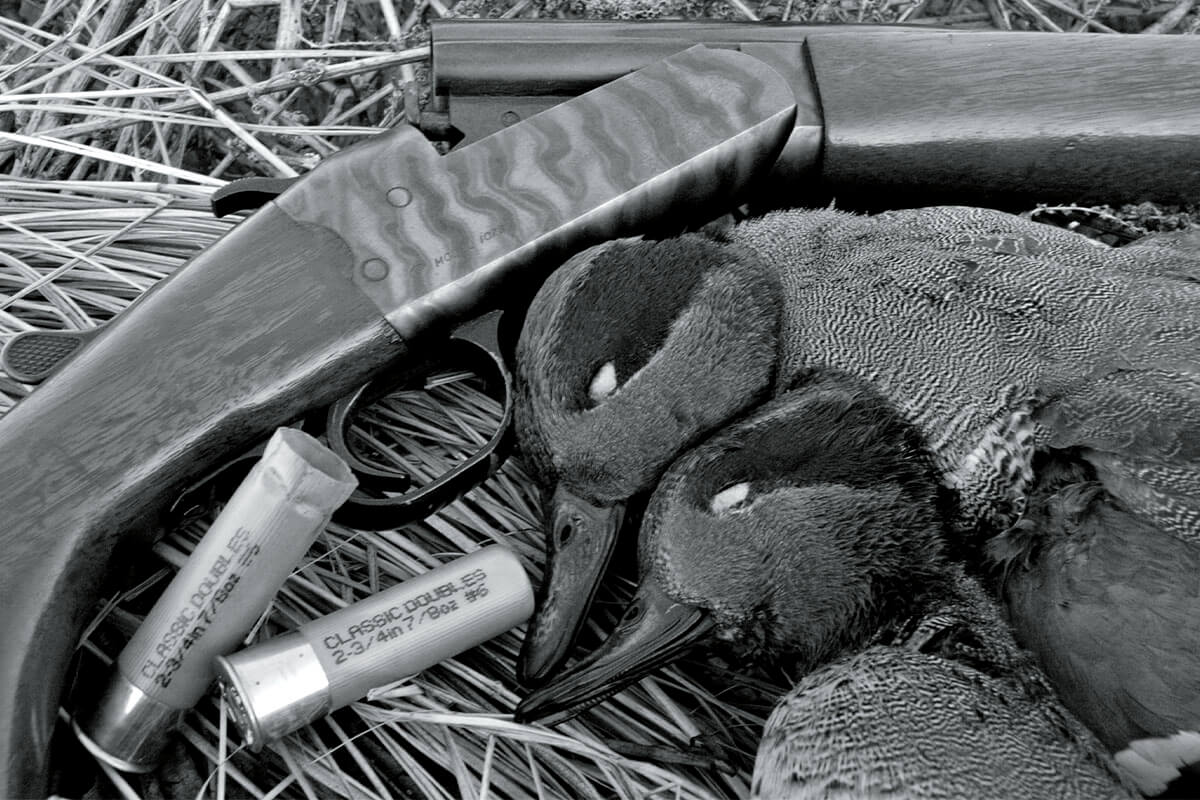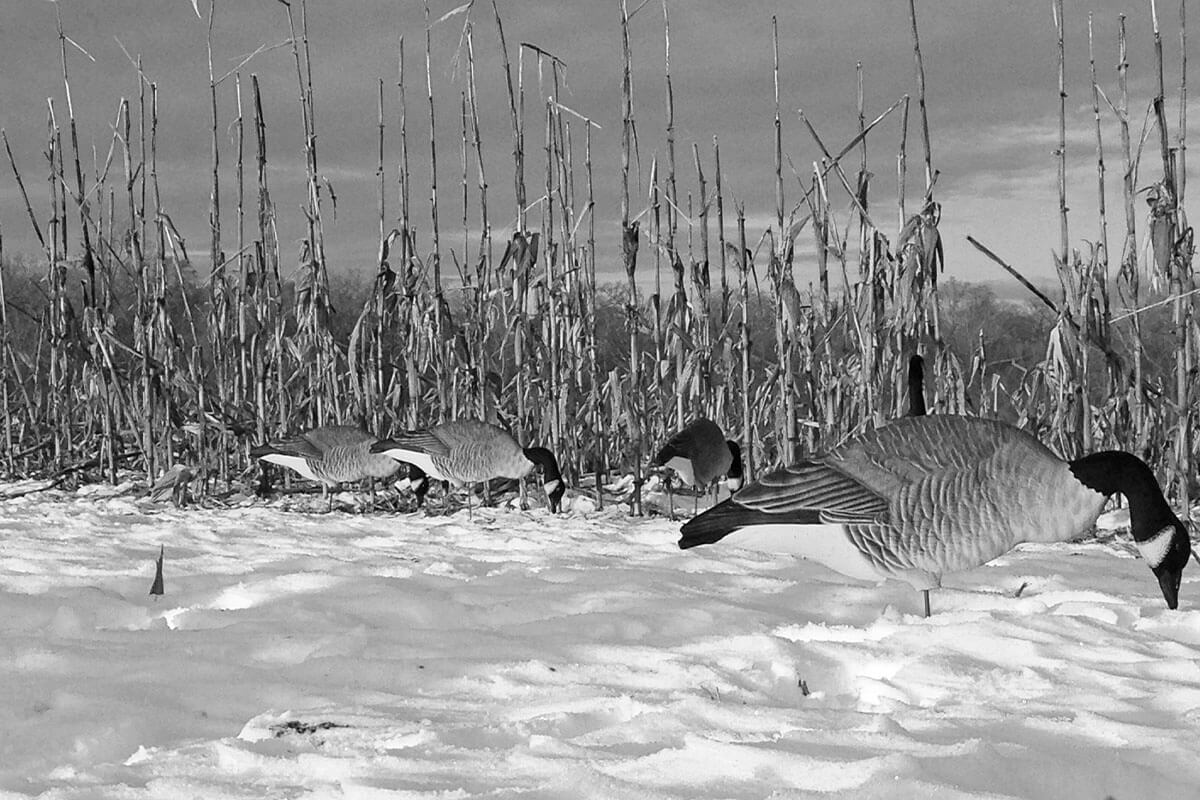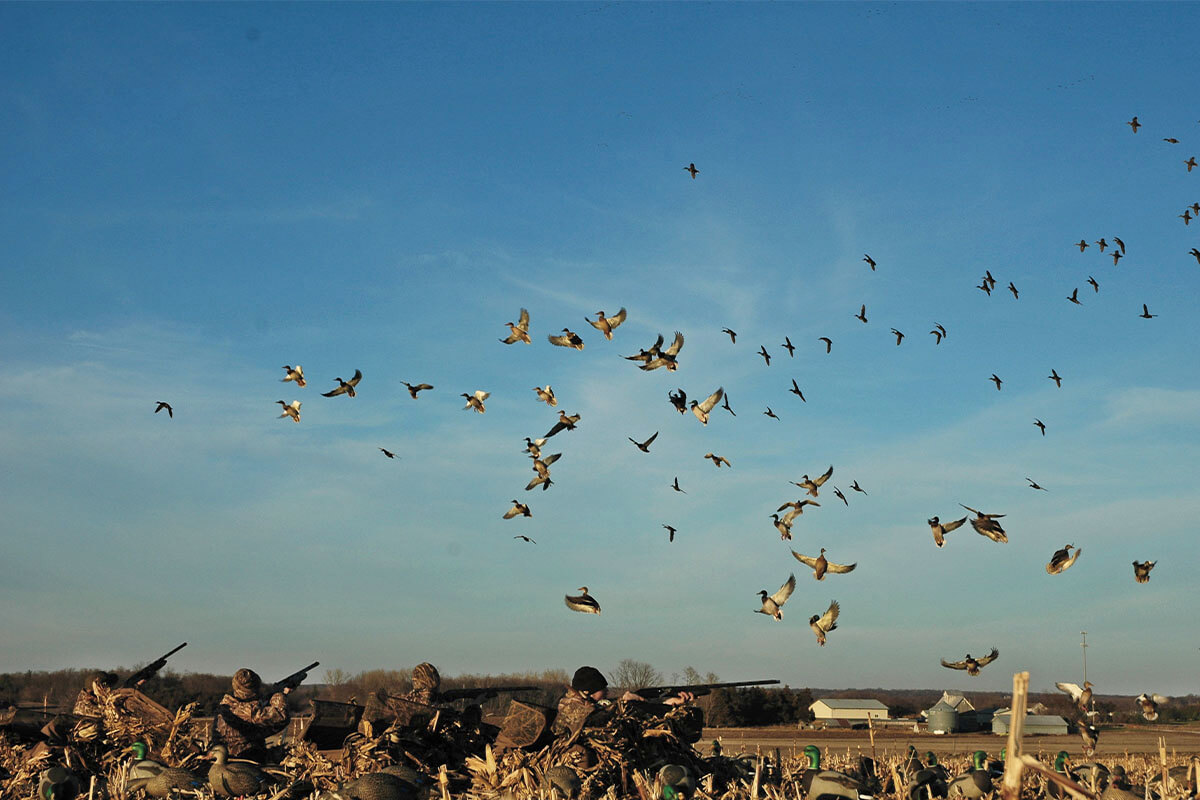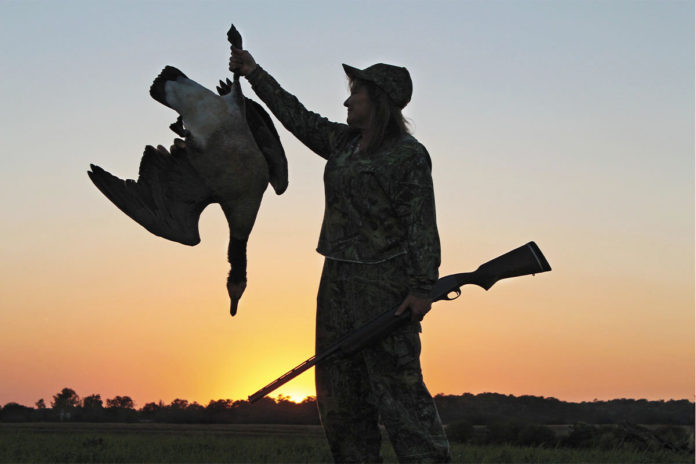Classic duck and goose hunting strategies that are still simply lethal.
December 26, 2021
By the time y’all read this, I will have turned 57. Neither here nor there, I reckon, but it means I’ve logged some 47 years since shooting my first duck. Almost half a century under the bridge. A lot of miles. People. Changes. The Point System. One ‘can. No ‘cans. Ten pintails daily. That’s right, young people, who are now limited to one-a-day. Ten pintails a day.
Forty-seven years. Guess that makes me old school. Now don’t get me wrong. I’m not anti-technology. I just think there’s a lot to be said about the old school way of doing things when it comes to duck and goose hunting.
That’s my point here. Old school. I do think back to 1974, 1980, 1982 — and realize we killed a lot of ducks, and our fair share of geese, too, long before the advent of $1,000 chest waders, $1,500 duck guns, and goose decoys that cost $90 apiece. How? Well, for one, we worked hard. That, and the men I knew back in The Day—Zink, Grounds, Saunders, Boyd, Mathewson, Mann, Vandemore, Latschaw, Johnson, The Paradise Brothers, Gardner, and Calef. Some familiar names, some known only to me, but they knew ducks. And geese. They thought the way the birds did. And they killed birds. Lots of them.
Can it work today, this old school theory? We’ve already seen a huge rise in the popularity of silhouette goose decoys. Jerk cords are coming back into vogue. The folks at Hevi-Shot tell me they’re selling a ridiculous amount of 28-gauge non-toxic ammunition. Coot decoys. Ghillie suits. The revered Olt A-50. Hiding in the bushes. Half a dozen hand-carved mallards. And, let’s not forget the $20 production double reed you know when to blow versus the $200 Mallard Mangler you don’t.

So I called some of the guys I knew. The duck hunters. The goose hunters. The old school guys. And I asked them “what still works?” All this new-fangled technology aside, what’s down there in the bottom of that bag of tricks that’s making for full straps? And maybe more importantly, why? Why, 30…40…70 years later, does it still work? Their answers were unexpected and enlightening, but not surprising.
The Science of Sihlouettes
I’ve had the pleasure of interviewing Sean Mann many times over the past 25 years. And each time, I’ve learned something. How to set a better spread. How to run a goose call more effectively. How to be a more efficient waterfowl hunter. And, the man is two-dimensional. No, not simple or lacking deep thought or understanding, but rather big on two-dimensional decoys. Silhouettes. Skinnies. Call ‘em what you will; Mann is a believer.

This wasn’t always the case, Mann, soon to be 60 in December, told me. “First,” he began, “I had to become a fan of silhouettes.” As the call-maker explained, when he grew up on the eastern shore of Maryland in the 1960s, full-bodied decoys weren’t available. The best he would see, “if you were lucky,” were G & H shell decoys. So, Mann continued, ‘fowlers used what they had, i.e. the G & H shells, or they made their own silhouettes out of Masonite or light plywood. Some took old tires, cut ‘em into thirds for goose “bodies,” added heads, and called it a spread.
In time, Mann said, he and others started using stuffers; taxidermy geese which, while ridiculously realistic, presented problems of their own. Next, it was silhouettes. In Mann’s case, Real-Geese. And, eventually, full-bodies, which he from time to time ran in tandem with his skinnies and shells. But, and despite their natural visual, full-bodies weren’t without their downsides. “Daylight,” Mann said, “and if the wind lays down, now you’re contending with dew or frost on those full-bodies and shells. Now, you’ve got glare.” And it was this glare on a morning in Alberta that proved a pivotal moment for Mann. “It should have been a fantastic shoot, and it was,” he said, “after we pulled the full-bodies and shells, and left the silhouettes. We eliminated the glare. I wasn’t sure,” he continued, “but then I’m watching the birds that should have been working earlier—and weren’t—now landing in the decoys. The silhouettes.”
Today, old school Real-Geese flats make up Mann’s Go-To rig. And he sets ‘em in a very specific pattern. Every. Time. “Twelve dozen Real-Geese,” he told me, “and I put them five to seven steps apart. Not five to seven feet; five to seven steps. You’re creating a huge footprint that’s visible from a great distance. It tells birds ‘there’s birds here,’ and by the time they get to you, there’s so much space in the spread, they can and will land anywhere in the spread.” It’s a giant ‘X’ with the blinds at the origin – Coordinates 0,0 – the arms 45 steps out, and the tips 70 steps apart. Three staggered lines of silhouettes from the tip to the origin. And then again. And again. And again. That’s it. Done.
“Space,” Mann insists, “is the secret to success with silhouettes. I am not a fan of silhouette decoys. I’m a person who has had enough days in the field with all kinds of decoys to see that silhouettes will work for me every day, as long as I’m setting up right.”
Flute Style Goose Calls: The Olt A-50
It ain’t no secret. You have to blow a short reed goose call in order to kill geese, preferably one in a see-it-from-space neon color and…yada – yada – yada.
I understand it. A short reed’s like a single reed duck call. A little bit more of a learning curve, but without question more versatile in terms of the sounds one can produce. But, with that all said, are old school flute calls like the famous PS Olt A-50 truly dead?
“When the short reeds came out, geese responded very well,” said David Jackson, the man behind DJ Calls. Jackson, 63, worked for Phillip Sanford Olt (PS Olt) and the Olt Family for 30 years before the company went out of business. The patriarch of the family, Phillip, started the call company in 1904, rumor has it in an old chicken coop, and has to his credit such legendary designs as the D2 duck call and A-50 flute. Following the doors closing at Olt, Jackson bought the tooling from the company, and has been for several years producing Olt-style calls under the new moniker, DJ Calls. “Yes, sir,” he continued, “the birds responded very well to these new short reeds. But now that everyone is using them and they’re screaming at these geese, well, that old flute call is just as mellow as can be. I call it a true hunting call. If you listen to geese, and I mean really listen to geese, that old flute call is right there.”
“Al Sonderman was a master call maker who worked for PS Olt from 1939 to 1982,” said Jackson. “Sonderman designed the A-50 in 1954. It was an entirely new technology from the old school break-over reed design. The first of the flute calls. It’s been modified a little bit (over the years), but the basic length, diameter, reed base, wedge. Really nothing has changed. The A-50,” he continued, “just makes that HER-ONK of that old goose. It just has that good old goose sound that still works today.”
And, yes, Mister Jackson. She absolutely does work well, even after 67 years. Thank you.
It’s Cool to Be a Jerk
I’m happy to admit it. I’ve never been a fan of spinning wing decoys (SWD). Tub toys, I’ve called ‘em. They’re big, bulky, eat batteries, and occasionally do more harm than good, it seems.
What I am is a fan of jerk cords. Simple jerk cords. Just some #550 black paracord, a one-pound collapsible grapple anchor, a piece of bungee, and two – TWO – water keel green-wing teal decoys. That’s it. I yank the string, the teal bounce around like Shakira and J-Lo at half time, and sometimes the ducks come around.
“Jerk cords create a more realistic on-the-water motion,” said Matthew Cagle, the man behind Rig ‘Em Right Waterfowl. “And that motion—that movement—just looks like real live ducks on the water.” SWDs, he said, can indeed grab a duck’s attention, but it’s not a natural motion. “Once the birds get close,” said Cagle, “they’re not going to flare off a duck swimming on the water. In other words, a jerk cord.”

Less Is More
You want to know why most guys on YouTube do that machine-gun rolling feed chuckle? Because they can, that’s why. It sounds cool. Same with the highballs, hail calls, comeback calls…you name it. Talent? Maybe? But does this cacophony kill ducks?
“I’ve always been a believer in ‘less is more,’” said Bill Saunders. Saunders, 49, is a ‘fowling household name, not only in the Pacific Northwest where he makes his home, but nationally, thanks in large part to the calls he’s been making professionally since 1999. “And the main reason is my spread, which is often fewer than 60 decoys. If you were to listen—I mean actually go outside and listen, not watch it on TV— to a flock of ducks or geese that size on the water, they’re pretty quiet. To me, it’s a realism thing.” If, Saunders said, you listen to ducks, you might here some back and forth feed chatter. Soft quacks. “But to hear loud hail calls,” he said, “you don’t hear it that much. I understand you have to get their attention. You have to pull birds your direction. Not everyone gets to set up on the ‘X,’ so you’ll use that call. But,” he continued, “once their noses are pointed at you being quiet and realistic is, to me, the best way to go.
Saunders also suggests, “some guys just aren’t all that skilled with a call. If you’re not a good caller,” he said, “keeping that call in your pocket more often might be the way to go.” Moderation, Bill. It’s all in moderation, eh?
As a side note. My Old Man always – ALWAYS – carried in the upper left pocket of his (Old School) brown canvas duck hunting coat an Olt D-2, attached, as it were, to said coat with a short piece of rawhide cord and a huge honk’n safety pin. Never once in all the years I hunted with him did I ever hear him blow it. Not once. “Why?” he said when I finally up and asked him. “I’m where the ducks want to be. They’re already coming here. Why scare ‘em off with that damn call I can’t blow?” Made sense then; makes more sense now.
Concealment Counts
This one’s easy. “If,” a young Luke Clark told me three or four years ago, “you’re not hiding, you’re not shooting.”
Clark’s been around the ‘fowling industry for some time now, wise beyond his 20-something years, and offered me that elemental tidbit of advice some time back.
He’s right. If you’re not hiding, you’re not shooting: However, too many ‘fowlers, I fear, are quick to fault a lack of success on their spread, the weather, hunting pressure, Russian hackers, or even the birds themselves. Heaven forbid those mallards want to practice j-u-u-u-u-stt a touch of self-preservation.

So we hide, and our take-home improves. We dig a layout blind down a bit. We stand back and look at our hide; I mean r-e-a-l-l-y give it a good going-over. We refresh the stubble. We make it our goal to blend the blind, not conceal it completely.
Ghillie jackets and pants? If that’s what it takes. My wife, Julie, and I killed six big Canadas, including four bands and three collars, one morning by wearing Ghillie jackets and hunkerin’ down in a semi-dry tile ditch behind 18 full-bodies. Geese never knew we were there, and we killed ‘em at 20 yards.
Why It Works
Worth Mathewson killed his first duck in 1953. A Virginia black duck taken with a Stevens Fox double 20 bore on Christmas afternoon, I’d gotten the shotgun that morning– at the age of 11.”
In the intervening years, Mr. Mathewson has authored seven books, including Big December Canvasbacks, a must-read for every ‘fowler, compiled 10 others, written for 43 different magazines, hunted in more than 10 countries — Iceland and Siberia are on that list — and has operated a punt gun in Northern Ireland. “The gun,” he wrote me, “was a double barrel shooting 16 ounces of shot from each barrel. I made one shot of about 15 teal and widgeon.”
If one inclined to define Old School Waterfowling, Worth Mathewson’s photograph would have to be front and center. I don’t wish to embarrass the man, but he IS the essence of traditional ‘fowling. Pure and simple. “I don’t think the ducks have changed,” he began quietly. “I haven’t noticed any difference.”
But, Mathewson hints, perhaps it’s the hunters themselves who underestimate something as simple as a duck. “There used to be a big wintering flock of canvasbacks on Yaquina Bay (near Newport, Oregon). Perhaps there still is,” he said. “I’d use my scull boat on them. And they caught on to that scull boat pretty quick. The first year, I had two successful sculls on two different days. But boy, after that, it was an uphill battle to get close to them. But what was truly interesting,” he continued, “was the next year, the first time I sculled them, it was the same uphill battle. I swear to God, those birds remembered after a year.”

What Mathewson said next tied it all together, at least for me. “I approached duck hunting,” he told me, “like I did fly fishing. A classic approach. Flies instead of a gob of worms or a spinner. The duck hunting was similar. Hand-carved decoys. The gun had to have two barrels, side by side. That was mandatory for me. And, of course, the old boats. When I was a young man,” he continued, “I was like any young duck hunter, and I wanted to kill ducks. But as I grew older, it became less important to kill a lot of ducks versus just having a good day.”
A good day, sir, surrounded by those things those ways —cloaked in the shadows of Time, and yet as viable today as they were when you pulled the trigger on that black duck in ’53. Old school, it seems, is anything but old.
Credit: Source link































